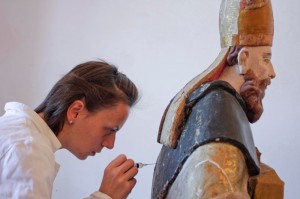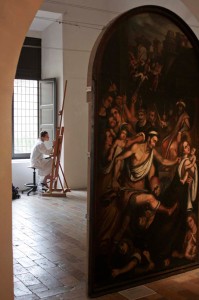Urbino students train to help preserve Italy’s artistic memories.
URBINO, Italy – Sitting on a short stool in a small, crowded laboratory inside the 15th century Ducal Palace, Daniela Pesca clasps a paintbrush firmly in her hand as she makes small, delicate strokes on the face of a painted, wooden angel.
Nestled in the heart of Raffaello’s hometown, the lab is where Pesca, an art restoration student at the University of Urbino, spends eight to nine hours a day working to restore priceless pieces of art from many different masters in her quest to earn a degree in a profession with an uncertain financial future.
Why?
“Passion,” said Pesca. “Only passion, and a bit of madness.”

A student of Michele Papi's works on a wooden statue in the art restoration lab. Three types of restoration are taught in the lab: canvas paintings, painted wood, and contemporary art.
With great artists such as Raffaello, Michelangelo, and Leonardo, Italy is often considered the center of the world, a title Italians consider central to their culture. The works by those great names have lasted through centuries, but they needed help withstanding the blemishes of time.
The University of Urbino has taught generations of Italians to provide that help. Students like Pesca spend five years studying how to bring deteriorated and damaged art back to life.
Michele Papi, head of the program and U of Urbino alum, instructs his students in the same rooms that he received his own education. He teaches three types of restoration: canvas paintings, painted wood, and contemporary art.
According to Papi, preserving paintings and other pieces of art is very important because they “are the historical memory of our country.”
[pullquote]The fundamental things you have to teach students are, first of all, the love for art, then the respect for art, and for the piece of art.[/pullquote]
“The fundamental things you have to teach students are, first of all, the love for art, then the respect for art, and for the piece of art,” Papi said. “You must also make the students understand that when you restore a piece of art – it may be a painting, a painting on wood, or a frescoe – the approach that the student has to have is that of never altering the subject.
“Every operation you do on the painting must never alter the actual look of the piece of art.” .
Along with learning the fundamentals of art restoration, students must learn the techniques of individual masters so they know how to restore the work properly. Pesca provided the example of restoring a painting by Michelangelo Merisi Caravaggio.
 This Renaissance master emphasized light contrasts and shadows in his paintings, and would use those shadows to enlighten some characters instead of others. He would also use people from the streets to depict some of the scenes he painted of angels, or even the Virgin Mary. According to Pesca, many of his pieces of art were refused by his clients because they were too realistic.
This Renaissance master emphasized light contrasts and shadows in his paintings, and would use those shadows to enlighten some characters instead of others. He would also use people from the streets to depict some of the scenes he painted of angels, or even the Virgin Mary. According to Pesca, many of his pieces of art were refused by his clients because they were too realistic.
Knowing details like that is crucial to the proper restoration of a piece of art, she said.
“It is important because if you don’t know how the work is built, you can do nothing,” said Daniele Costantini, a fourth-year restoration student. “So we have two exams concentrated on art techniques,”
According to Costantini, art restoration students do not have to be skilled artists themselves, but they have to have at least a sense of color and a certain ability with their hands.
“The restorer is never an artist, he never has to be,” Costantini said. “You can never overlap with the artist’s hand.”
Art restoration students spend all day in the lab, adorned with white lab coats, crouched over works of art, scraping away old paint, and restoring original details with the utmost concentration and care.
Spending so much time in the lab can be tiring and stressful for students, especially when they have other classes to study for. Art restoration students also have lessons in art history, chemistry, and molecular biology.
The program is also very expensive, by Italian standards. Most students at the University of Urbino would pay $950-$2,000 (750-1,500 Euros) for tuition. But since the art restoration lab requires the use of so many materials, art restoration students must pay more for their program. According to Costantini, students have to pay approximately $6,300 (5,000 Euros) for their program, along with paying for their own housing. Often students will not have time to work an outside job and must rely on their family for financial support.
“We are lucky enough to have our families helping us, otherwise it would be impossible,” said Pesca. “And it would be hard to work because we spend eight hours inside the lab. So we cannot work now, we must get help from our family. There are scholarships, but they are few.”
In order to become a professional art restorer, students have to pass an entry exam, complete the university’s five-year program, pass a final exam, write a thesis and then defend it in an oral exam. After that, they will be officially recognized by the Ministero Dei Bemi Culturali (Ministry of Cultural Art), and can legally restore art.
However, it wasn’t always this way.
In the past, those interested in becoming art restorers only needed to attend regional courses, or even learn from craftsmen and other art restorers. In 2001, the Italian government started asking all those becoming art restorers to obtain a degree, and for the past 11 years there were only two schools that would officially give art restoration diplomas: the Central Institute for Restoration in Rome and the Opficio Delle Petre Dure in Florence.
However there were still many other restorers who were in a “non-ruled” situation and were not getting a scientific education, according to Papi.
[pullquote]So we tried in these 11 years, to make them understand that the university is fundamental, not only for research, but also in the restoration field.[/pullquote]
“So we tried in these 11 years, to make them understand that the university is fundamental, not only for research, but also in the restoration field,” Papi said.
The Italian government finally agreed this year, and the new law now requires art restorers to obtain a university degree. According to Papi, it will take some time for the law to be fully effective, but the students getting their degree this year will have an easier time finding a job versus those who did not obtain their degrees from an officially recognized program.
When it comes to finding jobs, students face another challenge. According to Papi, there’s plenty of work to be done, but the financial crisis gripping Italy is drying up both government and private funding.
“The state right now is in a very bad economical situation, so it manages to give some funds, but unfortunately they are not enough to cover the immense artistical richness we have in Italy,” Papi said.
The students themselves are well aware of how tough the current job field is, but their passion for art keeps them hopeful.
“I will try to find a job here, but if it is impossible I will go out of Italy,” said Pesca. “I don’t know how, but I will try.
“I consider myself lucky because we have the chance to work on pieces of art representing our national identity. And art is the history of our past. And without our past, we are nothing. We are the history of our past. So we need to protect it.”
Multimedia